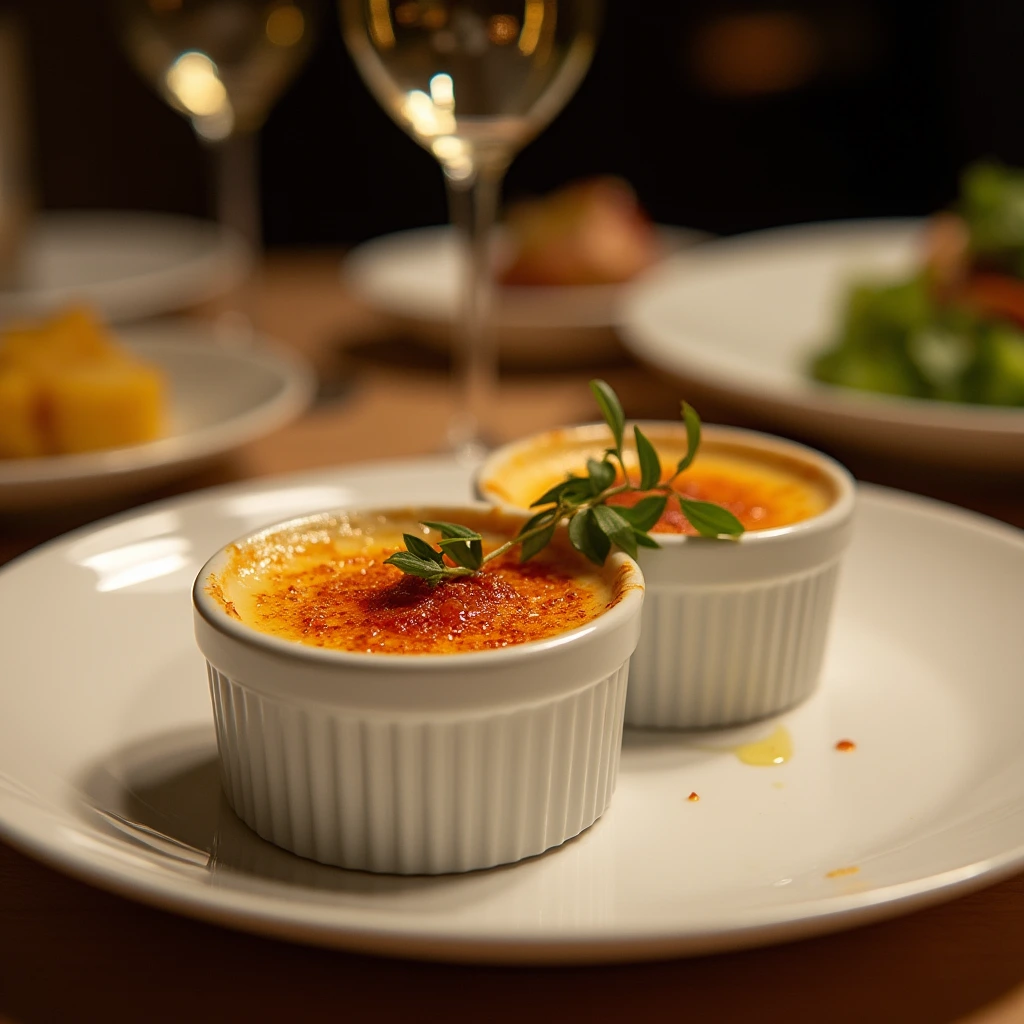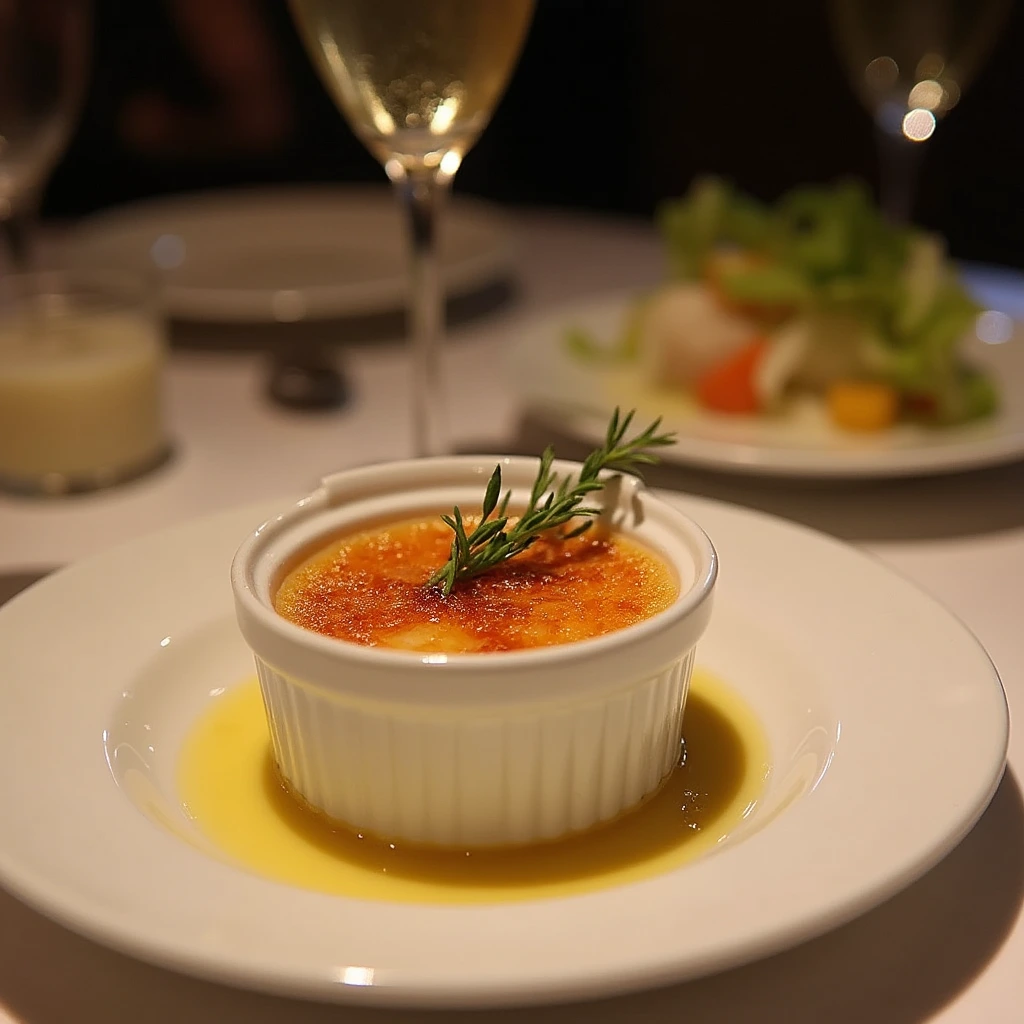Crab brûlée is one of those rare dishes that seamlessly combines sophistication with comfort. Imagine serving a beautiful golden-crusted dish that looks like a dessert but tastes like an indulgent seafood delight. This unique twist on the classic crème brûlée brings the luxurious crab flavours together with the creamy custard richness and the satisfying crunch of caramelized sugar. Whether you’re an experienced home cook or just starting, this recipe will elevate your culinary skills and impress your guests.
In this comprehensive guide, we’ll walk you through everything you need to know to make the perfect crab brûlée, step by step. From selecting the right ingredients to tips for achieving the ideal texture and flavour balance, you’ll be prepared to create a memorable, elegant dish. Let’s dive in and make your next dinner party one to remember!
Table of Contents
What is Crab brulee recipe?
Before we get into the nitty-gritty of the recipe, let’s explore what makes crab brûlée such a special dish. If you’re familiar with crème brûlée, you’ll recognize the basic concept — a creamy custard topped with a crispy sugar crust. However, in crab brûlée, the sweet custard is replaced with savoury crab, making it a truly unique culinary experience.
The idea behind crab brûlée is simple: take the elements of a traditional French dessert and reimagine them as asavouryy dish. The sweet, caramelized sugar topping provides a delightful contrast to the richness of the crab, making it an elegant appetizer or main course.
Why Crab brulee recipe?
You might wonder, why combine seafood with something that’s typically sweet? The answer lies in the contrast of flavours and textures. The creamy custard base provides a delicate buttery backdrop to the savoury crab, while the caramelized sugar adds a satisfying crunch that elevates each bite. It’s an elegant dish that will wow your guests and leave a lasting impression. Whether for a special occasion or a casual dinner with friends, crab brûlée is guaranteed to be a conversation starter.
Ingredients for Your Crab Brûlée Recipe
You’ll need to gather the following ingredients to make a crab brûlée that’s as delicious as it is impressive. Quality matters here, so use the best crab for maximum flavour.
| Ingredients | Quantity | Notes |
|---|---|---|
| Fresh Crab Meat | 1 cup (200g) | A mild, sweeflavouror that complements the crab. |
| Heavy Cream | 1 cup (240ml) | Full-fat cream gives a rich and smooth custard base. |
| Egg Yolks | 3 | Large eggs for the best texture. |
| Unsalted Butter | 2 tbsp | Adds richness to the crab mixture. |
| Shallots (minced) | 1 tbsp | Optional for added depth and umami. |
| Garlic (minced) | 1 clove | Enhances the overall flavour profile. |
| Fresh Tarragon or Thyme | 1 tsp | Fresh herbs balance the crab’s natural sweetness. |
| Granulated Sugar | 2 tbsp | For the signature caramelized topping. |
| Salt & Pepper | To taste | Enhances the overall flavor profile. |
Ingredient Tips:
- Crab Meat: Fresh lump crab meat is best, but frozen crab works as well frozen crab works as well if you can’t find it. Avoid imitation crab for this dish.
- Cream: Always opt for heavy cream instead of half-and-half or milk. This ensures the custard is rich and velvety.
- Herbs: While tarragon and thyme are the most common choices, you can use herbs, like chives and parsley, for a different flavour profile.
Step-by-Step Instructions for Crafting Your Crab brulee recipe
Now that you’ve gathered all your ingredients let’s look at them to ensure your crab brûlée turns out perfectly every time.
Step 1: Prepare the Crab Meat
Start by preparing your crab meat. If you’re using fresh crab, gently pick through it to remove any shells or cartilage. If using frozen or canned crab, drain and press it gently to remove excess moisture.
- Cook the Crab: Heat a small pan over medium heat and melt 1 tablespoon of butter. Add the minced shallshallots andd arligarlicic sauté until soft and fragrant (about 1-2 minutes). Add the crab meat and cook for 2-3 minutes until heated. Be careful not to overcook the crab, as it will become tough. Set aside to cool.
Step 2: Make the Custard Base
While the crab is cooling, it’s time to prepare the custard.
- Heat the Cream: Heat the heavy cream over medium heat until it begins to simmer. Stir occasionally to prevent it from burning. Once simmering, remove from heat and set aside.
- Whisk the Egg Yolks: In a separate bowl, whisk the egg yolks with a pinch of salt and pepper. Slowly pour the hot cream into the egg yolks while whisking constantly. This process, called “tempering,” helps prevent the eggs from scrambling.
- Combine the Crab and Custard: Stir in the sautéed crab and herbs once the custard is smooth. The custard should be thick and creamy but still pourable.
Step 3: Assemble and Bake the Crab brulee recipe
Now that your custard and crab mixture is ready, it’s time to assemble your crab brûlée.
- Preheat the Oven: Set your oven to 350°F (175°C) and place a rack in the centre.
- Fill the Ramekins: Pour the crab and custard mixture into individual ramekins, filling each about ¾ full. Place the ramekins in a large baking dish.
- Water Bath Method: Add hot water to the baking dish until it reaches halfway up the sides of the ramekins. This gentle cooking method ensures that your custards cook evenly.
- Bake: Bake the crab brûlées for 25-30 minutes or until the custards are jet. You should be able to shake the ramekins without the custard sloshing around gently. The tops should be firm to the touch.
Step 4: Caramelize the Sugar Top
This is fun — adding the signature golden, crispy top to your crab brûlée.
- Sprinkle Sugar: Once the crab brûlées are out of the oven and have cooled for a few minutes, sprinkle a thin, even layer of granulated sugar on top of each custard.
- Torch the Sugar: Use a kitchen torch to caramelize the sugar until it turns golden brown. If you don’t have a torch, you can place the ramekins under a broiler for a minute or two but watch closely to avoid burning.
Tips for Perfect Crab brulee recipe
To achieve a flawless crab brûlée, here are a few tips to keep in mind:
- Crab Selection: The best crab for this recipe is fresh lump crab meat. Choose one with minimal added water or preservatives if you use canned crab.
- Don’t Overcook the Custard: Keep a close eye on the texture when cooking the custard. Overheating can cause the eggs to curdle, ruining the smoothness of the custard.
- Caramelizing the Sugar: A kitchen torch gives you the most control when caramelizing the sugar. Rotate the ramekins frequently to ensure even caramelization if you’re using a broiler.
- Resting the Custard: After baking, allow the crab brûlées to rest for at least 10 minutes before adding the sugar. This helps the custard set properly.
Serving Crab brulee recipe: Plating and Pairing Suggestions
Presentation plays a huge role in making this dish feel even more special. Here are some serving suggestions to take your crab brûlée to the next level:
Plating Tips
- Serve each crab brûlée in its ramekin to highlight the individual portions.
- Garnish with a sprig of fresh tarragon, thyme, or micro greens for a burst of colour.
- Palance the dish’s richness, and pair it with a side salad, like a light arugula salad with a citrus vinaigrette.
Wine Pairing
The richness of the crab brûlée calls for a crisp white or sparkling wine. Here are a few great options:
- Chardonnay: A full-bodied, oaked Chardonnay complements the creaminess of the custard.
- Sauvignon Blanc: This refreshing wine cuts through the dish’s richness with its crisp acidity.
- Champagne: Opt for a dry Champagne or sparkling wine for a truly luxurious pairing.
Why Crab brulee recipe is the Ultimate Dish for Special Occasions
Crab brûlée isn’t just a dish — it’s an experience. From the first glance to the last bite, it’s a meal that tells a story of craftsmanship and elegance. It’s perfect for impressing dinner guests or creating a memorable meal for a loved one. Whether it’s a holiday celebration, a romantic anniversary, or a special gathering, crab brûlée elevates any occasion.
This dish also showcases your culinary skills and creativity. Taking the classic crème brûlée and transforming it into a savoury masterpiece shows that you can think outside the box while still paying homage to traditional French techniques.


Frequently Asked Questions (FAQ)
1. What type of crab is best for crab brulee recipe?
Fresh lump crab meat is ideal for crab brûlée. Its texture and flavour complement the creamy custard. Avoid imitation crab meat, as it lacks the rich taste and texture you want in this dish.
2. Can I make crab brûlée ahead of time?
Yes! You can prepare and refrigerate the custard and crab mixture daily in aadv ance. W en you’re ready to serve, bake the custard, let it cool, and caramelize the sugar before serving.
3. Can I substitute the crab for another type of seafood?
Absolutely! You can substitute crab with lobster, shrimp, or even scallops. Just be sure to adjust the cooking time slightly depending on the type of seafood you choose.
4. How do I store leftovers?
Any leftover crab brûlée can be stored in an airtight container in the refrigerator for up to 2 days. To achieve the best texture, caramelize the sugar just before serving.
Conclusion: Master Crab Brûlée for a Dish That Stands Out
Now that you’ve mastered making crab brûlée, you’re ready to impress your guests and elevate your cooking game. This elegant dish combines the richness of seafood with the sweetness of caramelized sugar, creating a unique flavour profile that will leave everyone talking. Whether celebrating a special occasion or simply treating yourself to something extraordinary, crab brûlée is a dish that will always stand out.
So, what are you waiting for? Gather your ingredients, follow the steps, and create a culinary masterpiece that will leave your guests asking for the recipe. Happy cooking!
Call to Action:
If you enjoyed making this crab brûlée recipe, don’t forget to share your results with us on social media! Tag your photos with #CrabBrûléeMagic and join our community of seafood lovers. For more gourmet recipes, subscribe to our newsletter for new tips, tricks, and culinary inspiration.
Your Thoughts on This Recipe?
There are no reviews yet. Be the first one to write one.

